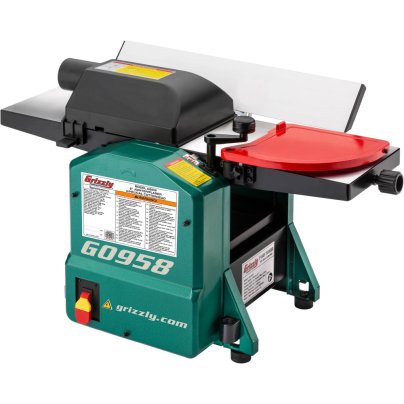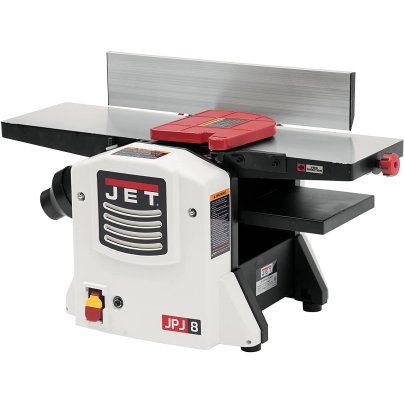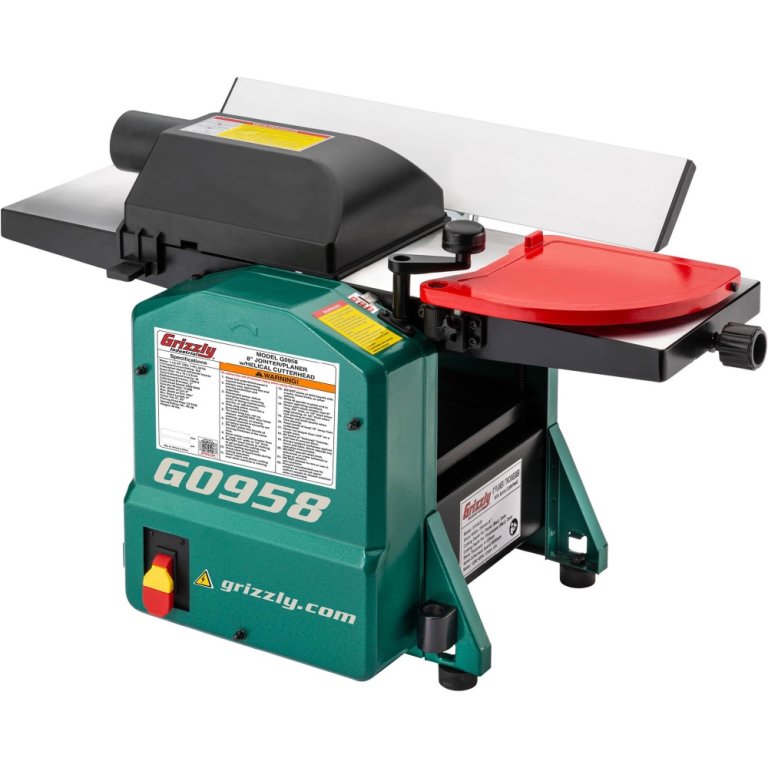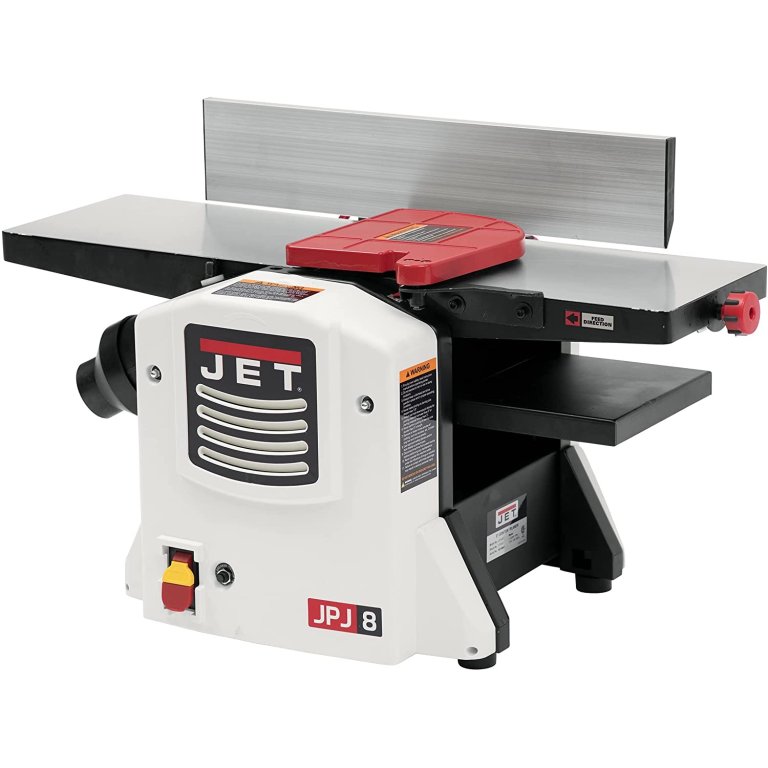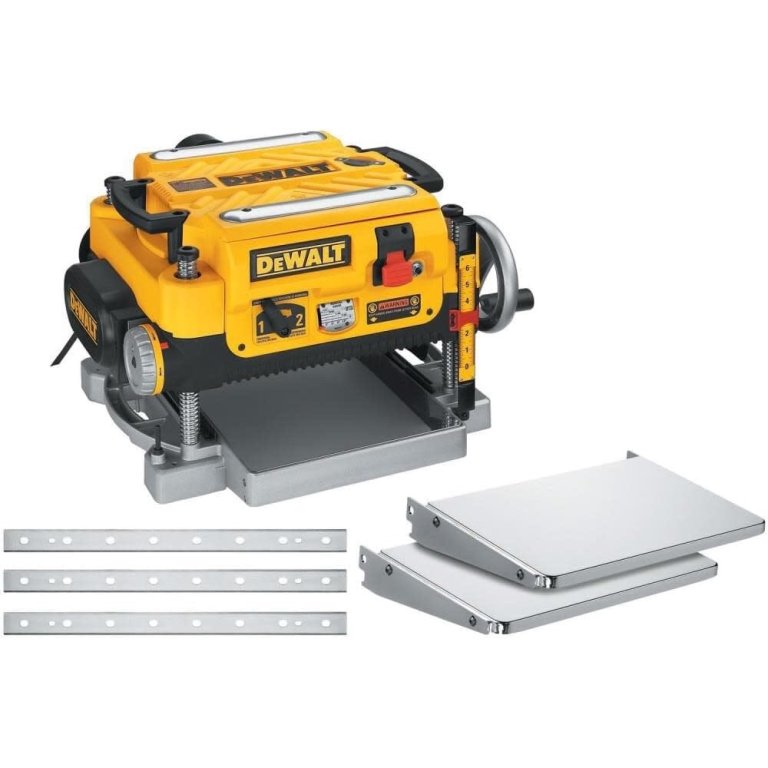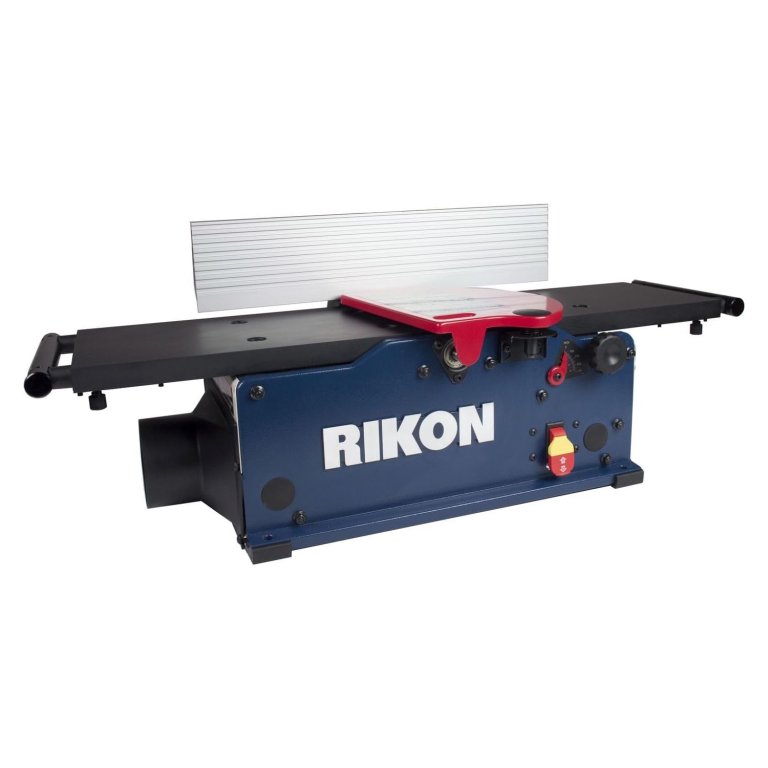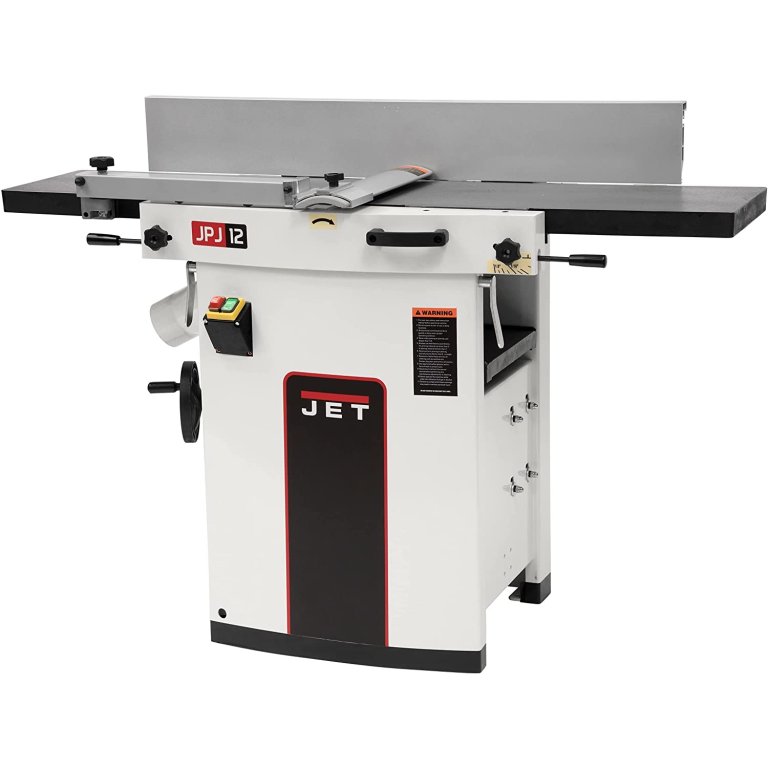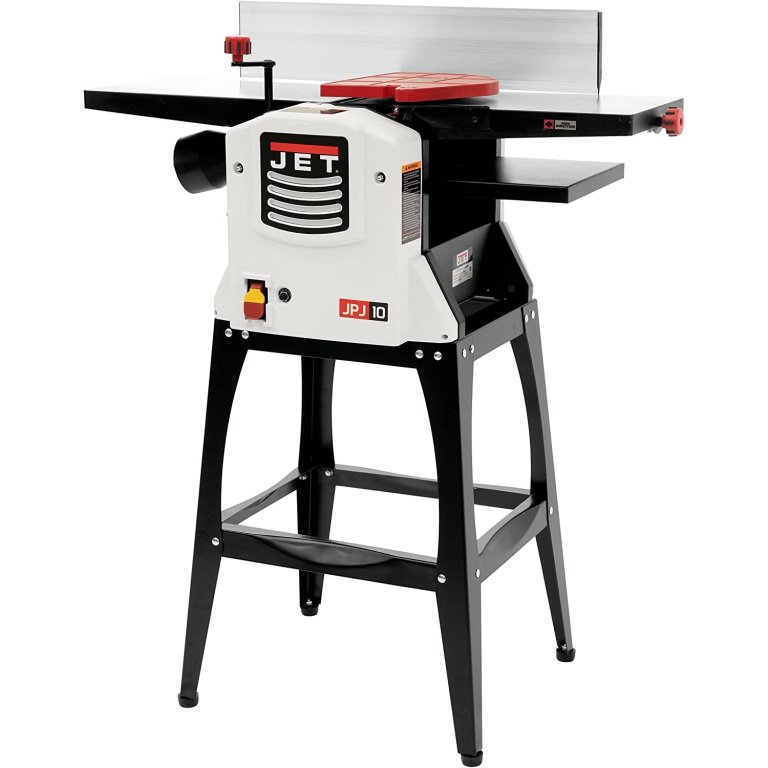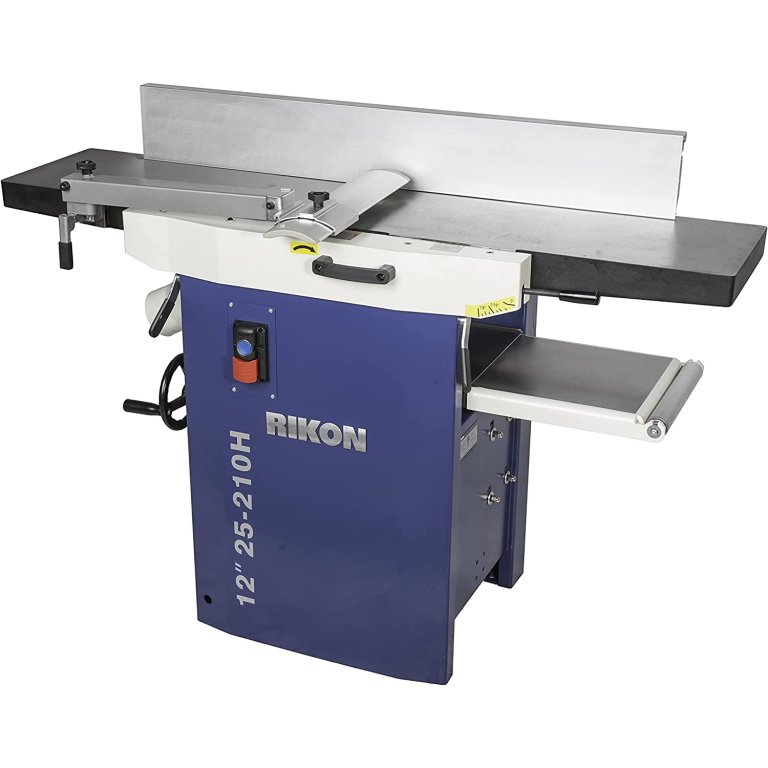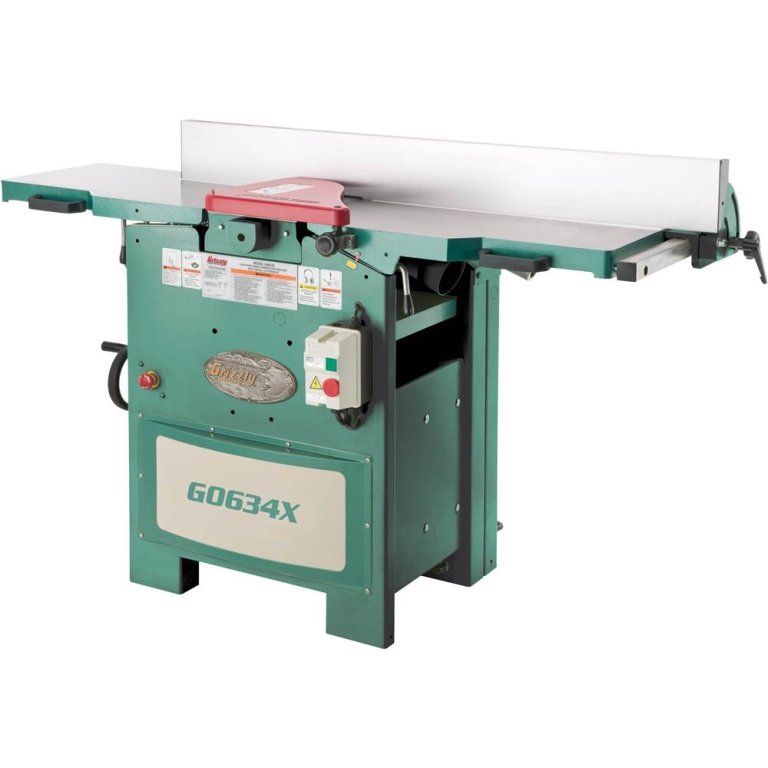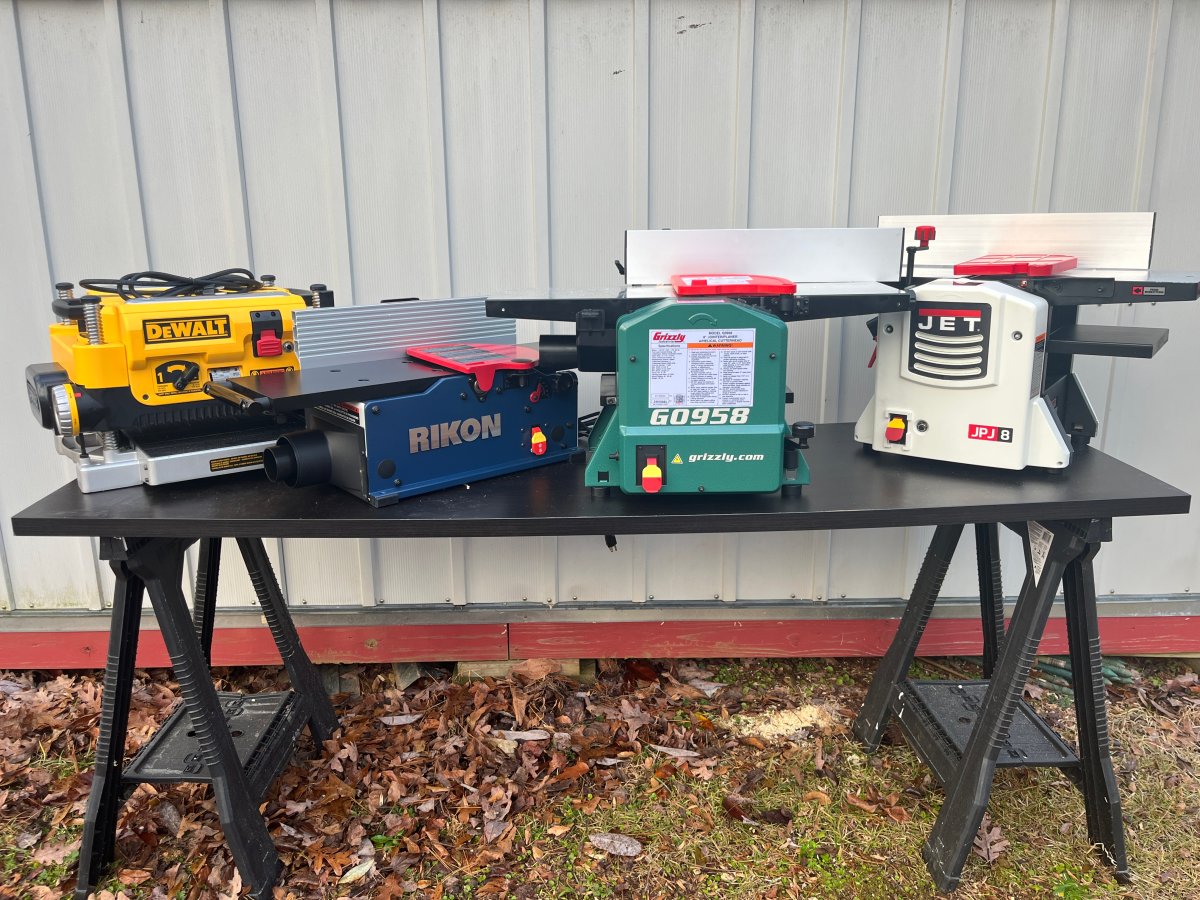
We may earn revenue from the products available on this page and participate in affiliate programs. Learn More ›
If you’re a woodworker with limited workshop space, you might consider buying a jointer planer combination tool to prepare boards. Combining a jointer, which flattens surfaces and squares the edges, and a planer, which evens the thickness, into a single machine saves valuable floor space. Buying one may also be more cost-effective than buying two separate tools. For this guide, we spent 8 hours testing two popular benchtop jointer planer combo machines along with a stand-alone benchtop planer and benchtop jointer for a side-by-side comparison.
Our favorite was the Grizzly G0958, an 8-inch jointer planer combo. It delivered the cutting power and smooth finish we expected from a high-quality, easy-to-operate benchtop model, and the price seemed fair for the quality. But some shoppers may prefer a less expensive tool, a larger model to support bigger projects, or upon further consideration, stand-alone planer and jointer machines. In any case, we’ve got you covered. Although we did not test the freestanding models listed below, they come from well-known brands and receive excellent user ratings. In this review, we highlight our top picks, our observations from testing, and the considerations to keep in mind as you choose the best jointer planer combo for your woodworking needs.
- BEST OVERALL: Grizzly G0958 8″ Combo Planer/Jointer
↓ Jump to Review - BEST BANG FOR THE BUCK: Jet JJP-8BT 8″ Planer/Jointer Combo
↓ Jump to Review - BEST BENCH TOOL PAIRING: DeWalt DW735X Planer and Rikon 20-800HSP Jointer
↓ Jump to Review - BEST FREESTANDING: Jet JJP-12 12″ Planer/Jointer with Helical Head
↓ Jump to Review - BEST WITH STAND: Jet JJP-10BTOS 10″ Jointer/Planer Combo
↓ Jump to Review - BEST CUT QUALITY: Rikon 25-210H 12″ Helical Planer/Jointer
↓ Jump to Review - BEST SUPPORT: Grizzly G0634X 12″ 5 HP Planer/Jointer
↓ Jump to Review
Before You Buy a Jointer Planer Combo
A high-quality combination jointer planer machine should offer a woodworker several advantages, but a quick glance at the market shows there are more choices for those buying individual machines. Each machine has its advantages and disadvantages; before you buy a combined jointer planer, you’ll want to think about these.
At first glance, a combo unit seems like an excellent idea. Having one machine instead of two can save space, particularly for the home user or a small one-person woodshop. They can also be more cost-effective (though not always). There is only one machine to maintain, and just one machine that will need new blades.
However, while switching from jointer to planer is usually straightforward, it does slow down production. This is particularly true if two people need to use the same machine. Rather than one person using the jointer while the other uses the planer, one of them will have to wait and perhaps reset the function.
It could also be argued that with just one cutter block (which we’ll talk more about in a moment), the blades will need to be changed more often. This is not only costly but time-consuming.
The following sections will help you assess whether the pros and cons of the market’s best jointer planer combos make them worthwhile or not.
| Testing Stats | |
| Products tested | 4 |
| Time spent testing | 8 hours |
| Tests performed | 6 |
| Price range | $600 to $1,300 |
Our Top Picks
Considering the prohibitive space requirements and higher prices of freestanding jointer planers, we focused our testing on high-performing benchtop models. These tools are ideal for the confines of a crowded garage or basement workshop.
Best Overall
Grizzly G0958 8” Combo Planer/Jointer
What We Like
- Extremely clean finished surface
- Easy-change cutter inserts
- Quick conversion between functions
- Plenty of power to resist bogging
- Good cutting accuracy
What We Don’t Like
- Dust-collection system gets in the way when planing
- Consistent snipe at board ends
Specs
- Power 120V, 15 amps
- Cutterhead 8,500 revolutions per minute (RPM) helical cutterhead
- Weight 55 pounds
Our Ratings: Assembly 5/5; Ease of Use 5/5; Accuracy 4.8/5; Value 4.7/5
Grizzly’s shop tools have a reputation for rugged performance and value pricing, and the G0958 is no exception. It boasts a powerful 1.5-horsepower (hp), 120-volt motor and 18-insert helical cutterhead. The cutter turns at a rate of 9,500 RPM, producing a smooth finished surface with minimal chipout. The table and fence are made of sturdy yet lightweight die cast aluminum. The 55-pound unit was the lightest combo model we tested, making it easier to move around the shop.
For its combination of space savings, ease of use, and cutting accuracy, the Grizzly benchtop jointer planer took top honors. We assembled this jointer machine in about 15 minutes. Our first test runs with pine and oak planks showed no appreciable difference in its ability to work softwood versus hardwood. Removing up to 1/16 inch per pass, the feed rates remained constant and the motor didn’t bog down.
Conversion between the two cutting modes took less than a minute. We had no trouble squaring the fence to the table, but the dust removal system was not quite perfect. In planing mode, the dust port rested directly above the planer infeed table, which caused our hose to hang down and obstruct the opening. We fixed the issue by tying the hose to an overhead hook. The planer left sniped ends, which we were not able to totally eliminate, but that was the case with every planer we tested, and it was easy to remove with a final pass or two on the jointer.
What our tester says: “In the case of an accidental over-adjustment, the Grizzly benchtop jointer planer had plenty of power to remove ⅛ inch without bogging down. Although I would not recommend doing that regularly, the finish was perfectly smooth.” —Mark Wolfe, Product Reviews tester and writer
Get the Grizzly jointer planer combo at Lowe’s, Tractor Supply Co, The Home Depot, or Grizzly Industries.
Best Bang For The Buck
Jet JJP-8BT 8” Planer/Jointer Combo
What We Like
- Ideal for home workshops
- Tall fence gives good support
- Competitive price
What We Don’t Like
- Fiddly table adjustment
- Plastic casing
Specs
- Power 120V, 13 amps
- Cutterhead 9,000 RPM two-knife cutterhead
- Weight 58 pounds
Our Ratings: Assembly 4/5; Ease of Use 4.5/5; Accuracy 4.5/5; Value 5/5
Weighing in at 58 pounds and with a table length of 29 inches, the Jet JJP-8BT jointer planer combo is a reliable space saver for the shop. It is lightweight enough to be of use to jobsite carpenters, and comes with one of the lowest prices for a combo jointer planer from a reputable brand.
Despite its modest dimensions, the Jet JJP-8BT offers good performance. The motor seems to be the same model used for the 10-inch Jet jointer planer. It drives the two-knife cutterhead at 18,000 cuts per minute and provides a feed rate of 19½ feet per minute (FPM). Maximum depth of cut is 5/64 inch.
Setup took us a little longer for this unit, as there were a few more accessories to install, and the bolt holes on the table didn’t line up perfectly with those on the cutter guard mounting plate. The planer outfeed table was a bit fiddly to level, as well.
As expected on a budget jointer planer combo, the tables are extruded aluminum and sheet metal rather than cast iron. But they are decent quality and offer good workpiece support, as does the tall fence. The 4-inch dust port comes with a 2½-inch adapter that works with smaller shop vacs, and it worked well with ours.
As for the cut quality, the two-knife cutterhead was just okay compared to helical cutters. This machine did a good job attaining the dimensions we needed, but the final product will require more sanding prior to finishing.
Get the Jet JJP-8BT jointer planer at The Home Depot,Northern Tool + Equipment, Acme Tools, Rockler, Woodcraft, or ToolUp.com.
Best Bench Tool Pairing
DeWalt DW735X Planer
What We Like
- Dedicated machines equals fewer adjustments
- Less blade wear
- Longer jointing feed table
- Wider planing capacity
What We Don’t Like
- Takes up more space than a single machine
- More expensive than a single machine
Specs
- Power 120V, 15 amps
- Cutterhead 10,000 RPM three-knife cutterhead
- Weight 101 pounds
Best Bench Tool Pairing
Rikon 20-800HSP Jointer
What We Like
- Dedicated machines equals fewer adjustments
- Less blade wear
- Longer jointing feed table
- Wider planing capacity
What We Don’t Like
- Takes up more space than a single machine
- More expensive than a single machine
Specs
- Power 120V, 10 amps
- Cutterhead 12,000 RPM helical cutterhead
- Weight 49 pounds
Our Ratings: Assembly 4.5/5; Ease of Use 5/5; Accuracy 5/5; Value 4.7/5
To highlight the difference between working with a jointer planer combo versus separate wood jointer and wood planer machines, we tested the DeWalt DW735X planer and Rikon 20-800HSP jointer. The 13-inch planer alone weighs twice as much as either of the combo machines we tested, so it requires two people to lift and carry when needed. The 8-inch jointer was similar to the combo units in size and weight, but it included premium features such as extendable board supports on the infeed and outfeed tables, as well as a buttery-smooth depth adjustment system.
Each of these machines is a top contender in its own category, and together they outperformed the combo machines when it came to adjustability, ease of use, and finish quality. The DeWalt wood planer has a much larger capacity than the combo units, accepting boards up to 13 inches wide and 6 inches thick. It is equipped with a three-blade cutterhead that will keep a sharp edge longer than the combo units, and a two-speed feed switch that allows users to choose their preferred finish (slower feed for a finer finish, faster feed for higher production).
As for the Rikon jointer, its helical 16-insert cutterhead, which rotates at 12,000 RPM, produced a finish that was similar to the Grizzly cutterhead moving at 9,500 RPM with 22 inserts. So the big difference here is in efficiency. The 10-amp Rikon uses less power than the 20-amp Grizzly, but I would expect the Grizzly’s cutters to last longer since they spread the workload over more cutters. While finish quality is similar between our Best Overall pick and these separate tools, Grizzly would be our pick for space and money savings, but we’d go with the combination of DeWalt and Rikon to save the time and labor spent switching functions and changing cutters.
What our tester says: “The dual machine combo produced only marginally better results than the benchtop jointer planers. The expense of buying two machines may only make sense for those who process lots of boards. For small shops and occasional use, don’t be afraid to go with a combo machine.” —Mark Wolfe, Product Reviews tester and writer
Get the DeWalt planer at Amazon, The Home Depot, Acme Tools, or Rockler.
Get the Rikon jointer at Amazon, Acme Tools, Woodcraft, or Rockler.
More Great Options
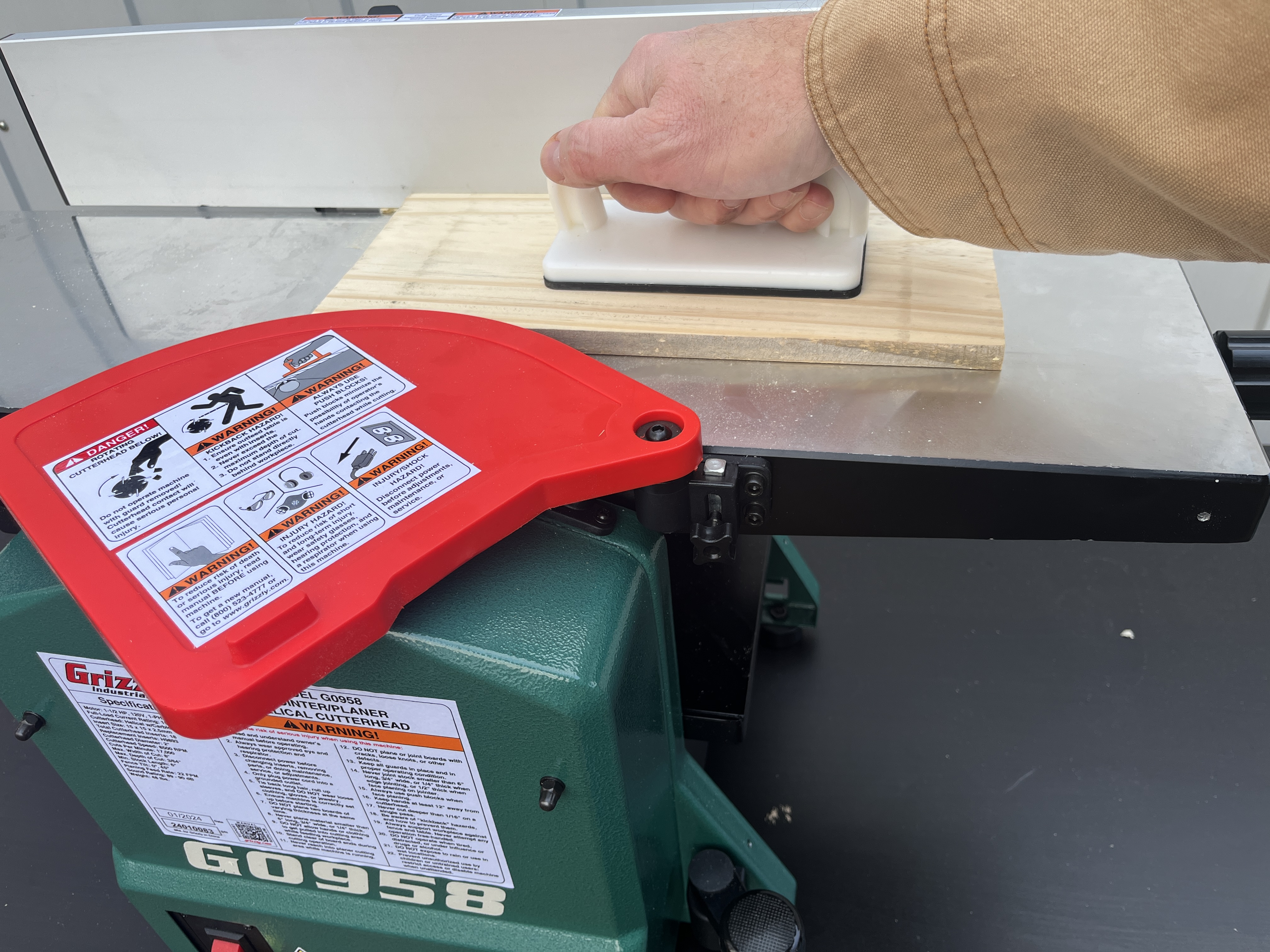
Benchtop jointer planer combos save workshop space and cost less, but they lag behind freestanding models when it comes to cutting power and production speed. If you need a larger machine for heavy-duty use, one of these models could be right for you.
Best Freestanding
Jet JJP-12 12" Planer/Jointer with Helical Head
What We Like
- Cast-iron tables
- Easy-to-use controls
- Rapid change between functions
What We Don’t Like
- Requires upgraded supply
Specs
- Power 3 hp, 230V, 12.5 amps
- Cutterhead 5,500 RPM three-knife cutterhead
- Weight 500 pounds
Given that woodworkers have a variety of different needs, picking a single best jointer planer combo is no easy task. Jet produces a range of high-quality machines, and its 12-inch model offers a sturdy build, impressive power, and a reputation for fast and easy changeover between functions.
A reliable otally enclosed fan-cooled (TEFC) 3 hp motor drives the three-knife cutterhead at 5,500 RPM, with a maximum depth from a single pass of ⅛ inch. The feed rate is 20 FPM. The tables are cast iron and 55 inches long, providing solid workpiece support even with large stock. A steel cabinet provides a sturdy base, and for safety, the on-off switch locks out during function changeovers. It also needs a manual restart in the event of a power outage, so the machine doesn’t come back on unexpectedly. A 4-inch dust port serves both jointing and planing operations.
The Jet JJP-12 jointer planer combo is among the most competitively priced in its class. Those who are fastidious about finish quality might want to look at the brand’s JJP-12HH model, which has a helical cutterhead but costs substantially more.
Get the Jet JJP-12 jointer planer at Amazon, ToolUp.com, ToolNut, or JB Tools.
Best With Stand
Jet JJP-10BTOS 10" Jointer/Planer Combo
What We Like
- Suitable for benchtop or stand use
- Very competitive performance
- Great cost value
What We Don’t Like
- Aluminum and steel tables
Specs
- Power 120V, 13 amps
- Cutterhead 9,000 RPM two-knife cutterhead
- Weight 74 pounds
The Jet JJP-10BTOS 10-inch jointer/planer combo strikes an excellent balance between performance and price. It can be used as a benchtop model or fitted to the supplied stand, and it runs off a standard household electric supply. This tool can be a great choice for the at-home woodworker or a small professional shop.
The two-knife cutterhead runs at 9,000 RPM and has a feed rate of 19½ FPM. Its maximum depth of cut is ⅛ inch in jointer mode and 5/64 inch when planing. Changeover is fast and simple. There is a 2½-inch dust port, and a 2½-inch to 4-inch hose adapter is also included.
A 36-inch table length provides good workpiece support, though the tables are made of aluminum and steel rather than cast iron, so the machine isn’t quite so rigid. The upside is that it is relatively easy to move around. The stand is a little fiddly to assemble and needs to be checked regularly, as nuts can work loose. However, these are minor gripes, and as a whole, the Jet JJP-10BTOS jointer planer combo offers outstanding value.
Get the Jet JJP-10BTOS jointer planer combo at The Home Depot, Northern Tool + Equipment, MSC, or ToolUp.com.
Best Cut Quality
Rikon 25-210H 12" Helical Planer/Jointer
What We Like
- Creates very smooth surfaces
- Offers high productivity
- Solid build quality
What We Don’t Like
- Set up may be difficult for nonprofessional users
Specs
- Power 3 hp, 220V, 12 amps
- Cutterhead 5,000 RPM
- Weight 445 pounds
The key feature of the Rikon 25-210H jointer planer combo is the helical cutterhead. It has four rows of carbide blades (56 in all) rotating at 5,000 RPM. The resulting 20,000 cuts per minute produce a super-smooth surface straight out of the machine, so sanding is seldom necessary. A feed rate of 23 FPM also makes this a highly productive machine. Maximum cut is ⅛ inch in both jointer and planer modes.
This unit’s drive comes from a powerful 3 hp motor that requires a 220V supply. A 55½-inch cast-iron table provides excellent workpiece support. Combined with a strong metal cabinet, this provides the sturdy platform necessary for high-quality work. A 4-inch dust port is also fitted.
The Rikon 25-210H jointer planer combo is capable of delivering the performance demanded by professionals, but quality control can occasionally be an issue. The fence can come loose, and the controls may have some play, making setup more difficult. All this can usually be fixed fairly easily, but given the price, it is no surprise that some owners find this frustrating.
Get the Rikon jointer planer combo at Acme Tools, TSH Supply, Glenco Woodworking, or Dynamite Tool Co.
Best Support
Grizzly G0634X 12" 5 HP Planer/Jointer
What We Like
- Heavy-duty power and construction
- Helical cutterhead for fine finishing
- Very competitive price
What We Don’t Like
- Requires upgraded supply
- Very heavy
Specs
- Power 5 hp, 220V, 25 amps
- Cutterhead 5,034 RPM helical (4 rows) cutterhead
- Weight 610 pounds
Grizzly has a reputation for high-quality, durable machinery, and everything about the Grizzly jointer planer combo is focused on the performance demanded by professionals. The 5 hp motor delivers tremendous power and reliability. Measuring 59½ inches long, the cast-iron tables provide solid support for the largest workpieces, and the heavy-duty cabinet adds further rigidity.
The cutterhead is a four-row 48-blade helical unit providing 20,136 cuts per minute at a feed rate of 22 FPM, and the finish quality straight off the machine is excellent. Changing from one function to the other is also rapid, further increasing productivity. A 4-inch dust port is provided.
The Grizzly G0634X jointer planer combo is large and very heavy, so it is a tool best used in a pro shop. For a machine with a helical head, it boasts a remarkably competitive price. tool best used in a pro shop. For a machine with a helical head, it is remarkably competitively priced.
Get the Grizzly jointer planer combo at The Home Depot, Tractor Supply Co., or Grizzly Industries.
Jump to Our Top Picks
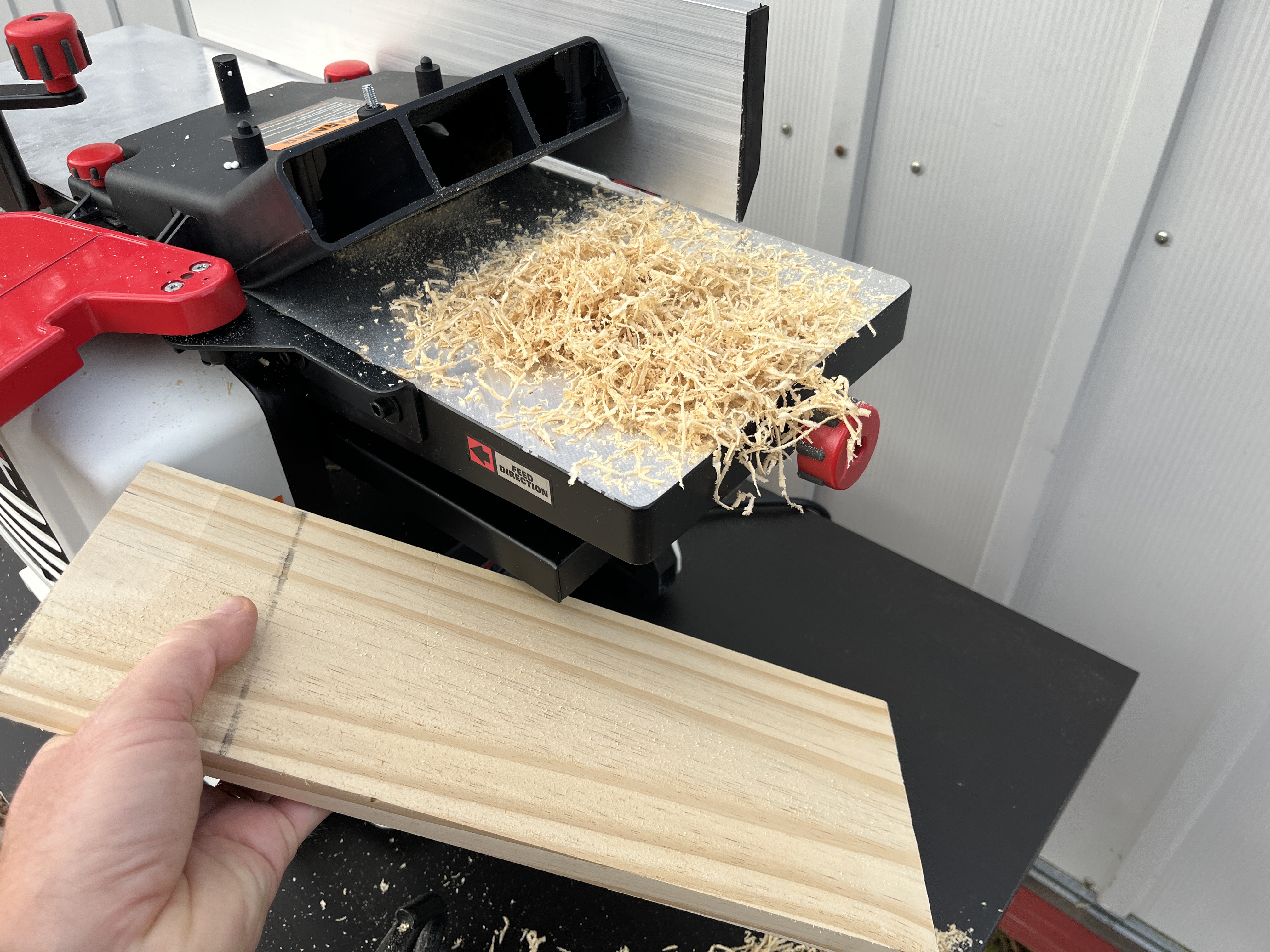
How We Chose and Tested the Best Jointer Planer Combos
We wanted to offer solutions for woodworkers with limited shop space, so we decided to test benchtop jointer planer combos. A quick scan of the market revealed a scarcity of options, but we sourced a couple of quality picks from Grizzly and Jet, along with the alternative of a bench jointer from Rikon and a bench planer from DeWalt. We used ten 1×6 rough-cut pine and ten similar oak boards to test each one. Our testing process involved flattening the board faces and squaring the edges on the jointers, planing the opposite faces, and then jointing the planed faces to remove snipe. Afterward, we noted our observations from evaluating each machine’s setup, adjustments, and board finish quality before scoring each one on our testing rubric and awarding titles.
What to Consider When Choosing a Jointer Planer Combo

It will come as no surprise that combining a jointer and planer in one machine requires considering many technical specifications, as well as several practical aspects. We have divided these into easy-to-understand segments that will walk you through a comprehensive overview of almost any jointer planer combo’s capabilities.
Size and Weight
One key benefit of a jointer planer combo is the amount of space it can save compared to having two machines. However, that doesn’t mean they are necessarily small. Jointer beds can be upward of 4 feet long; while the tool can be quite portable, larger models can weigh more than 500 pounds.
While checking the physical dimensions of a portable planer before buying isn’t necessary, doing just that when purchasing a jointer planer is vital in planning where the machine will be installed. Also, bear in mind that the tool may require some assembly. While assembly is not usually difficult, components can be heavy, so it’s a good idea to have some help.
Power and Speed
Amps are commonly used to define power-tool performance, but jointer planer combos usually use horsepower (hp). Few are under 1 hp, and large machines can be as high as 5 hp.
However, it is still important to check both the amp rating and voltage because they impact installation. A standard household outlet supplies a maximum of 15 amps at 110V. Some of these combo tools require more at 220/230V, so a separate or upgraded supply will be needed.
There are two measures of jointer planer speed:
- The feed speed is given in FPM. This is how fast the wood can travel through the planer. Higher speeds mean greater productivity.
- Cutterhead (or cutter block) speed is given in RPM. The faster a cutterhead rotates, the smoother the finish it provides. However, the number of blades (often called knives) must be considered.
Blades and Cutterhead Styles
The cutterhead of a traditional jointer planer holds two or three long knives, usually made of high-speed steel (HSS). The speed of the cutterhead multiplied by the number of knives gives the actual cuts per minute. For example, a two-knife cutterhead running at 9,000 RPM gives 18,000 cuts per minute. A three-knife cutterhead might run more slowly (5,500 RPM) but gives almost as many cuts (in this case 16,500 per minute) and probably runs more quietly.
An advance in this design is the helical (or spiral) cutterhead, which contains as many as 56 small square blades in rows that curve around the head. These are often made of tungsten carbide, which stays sharp longer than HSS. Thanks to the helical pattern, there is almost always a cutting edge engaged with the surface, so the finish quality can be excellent. Sometimes it’s so good that sanding is not required.
As the square blades become blunt, they can be loosened and rotated to a fresh, sharp edge. However, eventually, they will all need to be replaced, and this is a time-consuming operation. Machines with helical cutterheads are also considerably more expensive.
Bed Width and Cutting Depth
Jointer planer combos are usually defined by their bed width, the maximum size board that can be jointed or planed. We tapped the expertise of Jay Sanders, general contractor and owner of Baltimore-based Castle Dream Construction. “If you are a buyer, it is very critical to consider factors like bed length and width of a jointer planer combo,” he said. Machines are either 8, 10, or 12 inches wide, so checking the bed length is also a good idea. A longer bed gives the board more support and helps prevent sniping, which is when the cutter takes a deep chunk out of the board at the start or finish of the cut. However, it does impact the physical space required.
The maximum depth of cut on most jointer planer combos is ⅛ inches, although it can vary between the two functions. However, the final cut is usually more shallow to create a smoother finish.
Build Material
The material used for the tables and fence is a key feature of jointer planer combos. On entry-level machines, both of these are often extruded aluminum. This reduces weight and keeps costs down. However, there is a risk they might flex or twist, spoiling accuracy, so reinforcing webs are added. On some models, sheet metal may also be used. This is cheaper and more durable than aluminum but may eventually be prone to rust spots.
The best jointer planer combos often have an aluminum fence, but the tables will be cast iron. It is extremely rigid and absorbs machine vibration (both of which help improve precision), but it is also very heavy.
Stands are usually steel, though parts of the casing might be plastic on budget models. This doesn’t offer particularly good durability in busy workshop environments, but damage is usually cosmetic and shouldn’t affect function.
Stand Type
The smallest of our jointer planer combo top picks is designed as a benchtop machine, making it a good choice for home woodworkers or shops with limited space. However, most have some kind of stand.
Relatively lightweight models may have a stand that is a simple open steel frame bolted together, like a small table. It’s worth running a wrench around them from time to time as they can become loose with use.
For larger machines, the stand may be a fully enclosed cabinet. These provide the support required for cast-iron tables and help keep sawdust out of the planer mechanism. They don’t usually offer storage.
Dust Collection
Jointer planer combos produce a lot of waste. Without some kind of dust collection, wood chips and sawdust can get everywhere. It not only makes cleaning the workshop a chore, but airborne dust can ruin varnished finishes and is also a health hazard.
All jointer planers have an outlet port for attaching either a shop vac or a larger dust extractor. Diameters can vary, so it’s a good idea to check the models under consideration. Also, low-cost adapters are widely available.
FAQs
The information above consists of a comprehensive guide to the technical aspects of the best jointer planer combos and provides real-world examples. While many questions associated with these machines will be answered above, questions of a more general nature also crop up frequently. To help make the search for the best tool easier, we have responded to popular general questions below.with these machines will be answered above, questions of a more general nature also crop up frequently. To help make the search for the best tool easier, we have responded to popular general questions below.
A jointer is used to flatten the face of a piece of wood and plane an edge to 90 degrees. It can also cut bevels (chamfers), angling an edge at 45 degrees, for example. A planer is used to make both sides of the stock parallel and to plane it down to the required thickness. Hence, it is why they are often called thickness planers.
A jointer can plane rough stock to make it flat, and the stock could then be turned over and the other face planed. However, if there is any twist or taper in the board, planing both sides separately may not remove the twist. This is the job that a planer does well. Those who want to work with rough lumber need both machines or a jointer planer combo.
A table saw can be used to square an edge (and cut various types of joints), but only if the board is already flat. It cannot be used to true up the face.
Whether a jointer planer combo is worth it will depend on the type and volume of woodworking you do and the space you have available. The article above discusses the pros and cons and offers solutions for a variety of different sizes and price points to meet the needs of most woodworkers.
The traditional process for power tools is to use the jointer to flatten boards first, then use the planer to ensure an even thickness. In the absence of a jointer, a planer can be used to flatten cupped or twisted boards supported either by runners attached to the board edges, or mounted on a sled. After flattening one side, the board is removed from the runners or sled, flipped, and planed as normal.
Never use a planer on wood with loose knots, defects such as splits and cracks, or wood that may contain foreign objects like nails, staples, or bits of gravel. Painted wood should not be planed because the paint itself may dull the cutters and because the paint may be covering foreign objects.
Read, understand, and follow the operating instructions. Make sure the machine is in working order and that the cutters are sharp. Check the fence angle. Ensure the cutterhead guard moves and returns freely. Inspect the workpiece to make sure it is safe to joint or plane.
Meet the Tester
Mark Wolfe is a writer, product tester, and an avid DIYer who’s spent more than 20 years living in an older home. When he isn’t writing, he spends his time upgrading, repairing, and replacing anything and everything in his house, yard, and garden. He tests and writes reviews about power tools, lawn care, hand tools, home repair products, and outdoor living goods.
Additional research provided by Bob Beacham.
